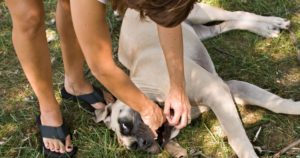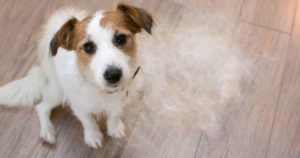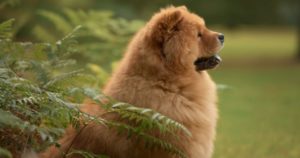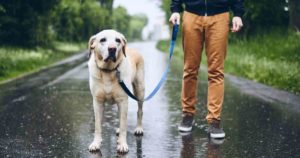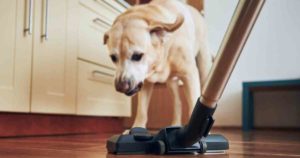It’s clear that your lab will eat anything that you set down in front of them. But that leaves the onus of making sure your lab has healthy chow firmly on you.
Especially if you’re a new lab owner, you might not be sure about the best kind of dog food for labs, however. In this article, we’ll dive into the things to look for when you’re picking dog food for your lab and then round up a handful of the best dog food for labs on the market.
What features are the most important in dog food for labs?
The most important features that you need to be on the lookout for when you’re picking dog food for your lab are quality, calories, coat support, and flavor. Among these features, food quality is the most important because it can make a big impact on the health of your lab.
Food Quality
Food quality is the biggest concern for any buyer of dog food because many dog foods are made with higher percentages of grains, ash, or fillers. These three ingredients are not optimal because they are essentially empty calories for your lab.
In other words, if your lab eats dog food which is largely ash or fillers, they could still be deficient in the nutrients that they need. But, on the other hand, if your lab eats food which is high in protein, healthy fats, and veggie-based carbs, they’ll get all the nutrition they deserve.
Most of the relevant stats are listed on the label of the dog food. If there isn’t a breakdown of the source of the nutrients and the proportions of the total that each type of nutrient accounts for, there’s a good chance that the food has a lot of fillers, which makes it low quality.
It isn’t like your lab will keel over and get sick if they eat these subpar foods. It’s that if you give your lab these foods in the long term, they may suffer from sub-optimal nutrition—even if they’re obese or have a higher weight than normal.
Weight Control
Picking foods that help your lab with weight control is critical because up to 25% of labs suffer from being overweight.
When your dog food is calorically dense but not filling, your lab will go looking for alternative sources of nutrition despite becoming overweight. It’s also possible that your lab will never feel full, so you need to be able to control their intake carefully.
Obesity leads to problems like hip dysplasia and potentially cancer. So, you need a dog food which will leave your lab feeling satisfied, but which won’t lead to gaining weight.
The best dog foods for your lab accomplish this task by being rich in protein and good fats which are derived from high-quality animal sources like fish.
Dog foods which are excessively high in fats or carbs tend to lead to weight gain. Remember, your labrador is a carnivore at heart, so fatty foods may be some of their favorites. But, if they don’t work out enough to offset calorie-dense foods, they’ll get fat quickly.
When your lab chows down on a protein-rich meal, they’ll feel more full — but they won’t necessarily gain weight if you keep their portions under control.
In our experience, a highly underrated feature of dog foods is the label. If the label doesn’t give you a good guideline for how much you should be giving to your lab, portion control will be much harder, and so your lab might gain more weight than they should.
Coat Support
Your lab is the happiest and prettiest when their coat has a luminous shine. Healthy coats mean that labs can jump into a cold stream in the middle of the winter and shrug off the water as soon as they hop out rather than getting soaked.
Furthermore, having a healthy coat means that your lab will shed less because they will retain their hairs for a bit longer.
The canonical way of getting your lab to have a great coat is to feed them fats that are high-quality and derived from animal sources. In our experience, the prototypical food for coat support is salmon, which is rich in protein and good fats.
So, the dog food that you pick for your lab should have these essential fats if it isn’t explicitly derived from salmon. Many dog foods add in these fats and other coat-supporting nutrients if their animal source material doesn’t already have them.
Flavor And Scent
Most labs aren’t picky, but it’s still worth keeping a favorite food on hand to cheer them up if they seem a bit under the weather. So, you should find at least one dog food that your lab seems to love eating more than the others.
More pragmatically, you should try to find a dog food that doesn’t have a scent which offends humans. Most dog foods don’t smell very good, which leads to owners storing dog foods far from human food — and often in sub-optimal areas.
Your dog will probably still enjoy eating the dog food if it smells good to humans too.
Lab-Friendly Dog Food Reviews
1. Open Farm Homestead Turkey & Chicken Recipe Sustainable Organic Dog Food
The Open Farm Homestead Turkey & Chicken Recipe Sustainable Organic Dog Food is a basic and effective dog food for your lab because it incorporates multiple protein sources into a tasty package.
This dog food also has a decent smell, good flavor, and protein derived from poultry that is comparatively rich in fats, like chicken, as well as leaner poultry like turkey. There’s no grains or filler in this food, which means that it’s not going to lead to weight gain unexpectedly.
You can also rest assured that there aren’t any harmful by-products derived from non-organic processing in this dog food.
The main disadvantage of the Open Farm dog food is that you don’t have much guidance on portion control or insight into the ingredients aside from the primary proteins.
Furthermore, the ambiguity of the label means that it is hard to judge the food’s fat content. This means that you may not get the coat support which your lab needs, so you may want to supplement your dog’s diet if you decide to go with this brand.
Pros & Cons
Pros
- Fully organic
- Multiple protein sources
Cons
- Label isn’t very descriptive
2. Castor & Pollux Pristine Wild-Caught, Free-Range or Grass-Fed Protein Dry Dog Food
Castor and Pollux’ Pristine dry dog food is an excellent example of dog foods for labradors because it incorporates high quality ingredients, great distribution of nutrients, highly informative labels, and wonderful fishy flavors for your dog to enjoy.
With this dog food, your dog will get the coat support they deserve as a result of the vitamin, mineral, and fat supplements which are added to the product. Furthermore, your dog will get many of these essentials from the salmon and whitefish that the food is sourced from.
The only issue is that this food’s title is slightly deceptive. While salmon is one of the protein sources in the food, there are also proteins derived from lamb and whitefish.
Likewise, pork fat is used as a fat source. This means that you may find this food to be a bit calorically dense for your dog. And if you aspire for your lab to be a pescatarian, you’ll need to find a different food.
Pros & Cons
Pros
- Great portion control guide
- Detailed breakdown of nutrition facts
- Great for coat support
Cons
- Contains processed lamb
3. Rachael Ray Nutrish Zero Grain Natural Dry Dog Food
The Rachael Ray Nutrish Zero Grain Natural Dry Dog Food is great for dogs who love the hearty flavor of potatoes but don’t need to gain any weight while they’re enjoying it.
There are a lot of great features of this dog food, including that it is gluten free and has a good nutrition guide. When your dog eats this food, they’ll get the protein-rich meal they deserve, but they won’t gain weight.
The food is rich in vegetables but contains no grains. This means that it’s a great holistic way to keep your dog healthy. The only issue is that it contains added chicken fat, which may not be as rich in the coat supporting nutrients as other forms of fat.
Nonetheless, this food is a great foundation to build on with other foods or treats. Because the proteins are derived from turkey, which is fairly lean, it’s a great food for long-term feeding or even weight loss.
Pros & Cons
Pros
- Contains mostly food-grade protein, not byproducts
- Gluten-free for dogs with special needs
- All ingredients manufactured in the US
Cons
- Contains added chicken fat
4. Eukanuba Breed Specific Adult Dry Dog Food
The Eukanuba Breed Specific Adult Dry Dog Food is probably very tempting for new dog owners who assume that a lab-specific food is the best product. While it is indeed a great choice, the story is a bit more complicated.
The Eukanuba Lab food has a few strengths, such as a high number of quality fats and added nutrients and minerals. It also has a relatively low calorie count per cup, which means that it could be a viable food to help your lab lose some weight.
But this dog food does contain grains. So, not all of the calories in the food are from protein. This means that you should probably get a food that is richer in protein for your pup if they’re still growing. If they need to lose a few pounds, however, it’s acceptable to let them eat some grains.
Pros & Cons
Pros
- Contains added fats for coat support
- Contains added nutrients and minerals
- Low calorie count per meal
Cons
- Contains grains
- Contains heavily processed animal byproducts
5. Blue Buffalo Wilderness High Protein Grain Free, Natural Adult Dry Dog Food
The Blue Buffalo Wilderness High Protein Grain Free, Natural Adult Dry Dog Food is a flavorful and nutritious mixture of protein-rich pellets which your lab will love, especially if they’re highly active.
With the Blue Buffalo Wilderness food, your lab will be getting a delicious mixture of high-protein food which provides more than enough vitamins, minerals, fats, and nutrients to support their overall health.
There aren’t any grains in this formulation, though there are ingredients like dried chicory root which may be a bit too much insoluble fiber for older dogs. On the other hand, if your dog is a working dog or is otherwise highly active, this is one of the best foods.
The nutrient and calorie-rich dog food ensures that your lab will have the staying power they need to be active all of the time. For less active dogs, they’ll probably gain weight when eating this food, however.
Pros & Cons
Pros
- Highly calorie dense
- Protein-dense
- Excellent for coat support and gaining weight
Cons
- Contains chicken byproducts
- Contains dried insoluble fiber
Wrapping Up
Overall, the Castor and Pollux Pristine dog food is the winner of our roundup because of its high quality, good nutrient distribution, and informative label.
In comparison to the other products we examined, the Castor and Pollux dog food is best for your lab because it is tasty, doesn’t smell bad, provides the nutrients that your lab needs, and provides you with the information that you need to help your lab stay at a healthy weight.
Because the Castor and Pollux food is derived from salmon and chickpeas — two great sources of protein and healthy fats — you won’t need to supplement your dog’s diet with anything else to maintain good coat health. You may even control some of your lab’s shedding as a result.
The runner-up product is the Blue Buffalo Wilderness Salmon dog food on account of its good mixture of ingredients. The only reason why it isn’t the number one pick is that its guide to portion control isn’t as easy to use as the Castor and Pollux food.
Now that you know which dog foods will be the healthiest for your lab, it’s time to find which one your lab seems to like the most. Remember that you have the final say about how much your dog gets to eat, especially if your lab seems to have a bottomless stomach!
Best Dog Food for Labs
It’s clear that your lab will eat anything that you set down in front of them. But that leaves the onus of making sure your lab has healthy chow firmly on you.
Especially if you’re a new lab owner, you might not be sure about the best kind of dog food for labs, however. In this article, we’ll dive into the things to look for when you’re picking dog food for your lab and then round up a handful of the best dog food for labs on the market.
What features are the most important in dog food for labs?
The most important features that you need to be on the lookout for when you’re picking dog food for your lab are quality, calories, coat support, and flavor. Among these features, food quality is the most important because it can make a big impact on the health of your lab.
Food Quality
Food quality is the biggest concern for any buyer of dog food because many dog foods are made with higher percentages of grains, ash, or fillers. These three ingredients are not optimal because they are essentially empty calories for your lab.
In other words, if your lab eats dog food which is largely ash or fillers, they could still be deficient in the nutrients that they need. But, on the other hand, if your lab eats food which is high in protein, healthy fats, and veggie-based carbs, they’ll get all the nutrition they deserve.
Most of the relevant stats are listed on the label of the dog food. If there isn’t a breakdown of the source of the nutrients and the proportions of the total that each type of nutrient accounts for, there’s a good chance that the food has a lot of fillers, which makes it low quality.
It isn’t like your lab will keel over and get sick if they eat these subpar foods. It’s that if you give your lab these foods in the long term, they may suffer from sub-optimal nutrition—even if they’re obese or have a higher weight than normal.
Weight Control
Picking foods that help your lab with weight control is critical because up to 25% of labs suffer from being overweight.
When your dog food is calorically dense but not filling, your lab will go looking for alternative sources of nutrition despite becoming overweight. It’s also possible that your lab will never feel full, so you need to be able to control their intake carefully.
Obesity leads to problems like hip dysplasia and potentially cancer. So, you need a dog food which will leave your lab feeling satisfied, but which won’t lead to gaining weight.
The best dog foods for your lab accomplish this task by being rich in protein and good fats which are derived from high-quality animal sources like fish.
Dog foods which are excessively high in fats or carbs tend to lead to weight gain. Remember, your Labrador is a carnivore at heart, so fatty foods may be some of their favorites. But, if they don’t work out enough to offset calorie-dense foods, they’ll get fat quickly.
When your lab chows down on a protein-rich meal, they’ll feel more full — but they won’t necessarily gain weight if you keep their portions under control.
In our experience, a highly underrated feature of dog foods is the label. If the label doesn’t give you a good guideline for how much you should be giving to your lab, portion control will be much harder, and so your lab might gain more weight than they should.
Coat Support
Your lab is the happiest and prettiest when their coat has a luminous shine. Healthy coats mean that labs can jump into a cold stream in the middle of the winter and shrug off the water as soon as they hop out rather than getting soaked.
Furthermore, having a healthy coat means that your lab will shed less because they will retain their hairs for a bit longer.
The canonical way of getting your lab to have a great coat is to feed them fats that are high-quality and derived from animal sources. In our experience, the prototypical food for coat support is salmon, which is rich in protein and good fats.
So, the dog food that you pick for your lab should have these essential fats if it isn’t explicitly derived from salmon. Many dog foods add in these fats and other coat-supporting nutrients if their animal source material doesn’t already have them.
Flavor And Scent
Most labs aren’t picky, but it’s still worth keeping a favorite food on hand to cheer them up if they seem a bit under the weather. So, you should find at least one dog food that your lab seems to love eating more than the others.
More pragmatically, you should try to find a dog food that doesn’t have a scent which offends humans. Most dog foods don’t smell very good, which leads to owners storing dog foods far from human food — and often in sub-optimal areas.
Your dog will probably still enjoy eating the dog food if it smells good to humans too.
Lab-Friendly Dog Food Reviews
Open Farm Homestead Turkey & Chicken Recipe Sustainable Organic Dog Food
The Open Farm Homestead Turkey & Chicken Recipe Sustainable Organic Dog Food is basic and effective dog food for your lab because it incorporates multiple protein sources into a tasty package.
Pros:
- Fully organic
- Multiple protein sources
Cons:
- The label isn’t very descriptive
This dog food also has a decent smell, good flavor, and protein derived from poultry that is comparatively rich in fats, like chicken, as well as leaner poultry like turkey. There’s no grains or filler in this food, which means that it’s not going to lead to weight gain unexpectedly.
You can also rest assured that there aren’t any harmful by-products derived from non-organic processing in this dog food.
The main disadvantage of the Open Farm dog food is that you don’t have much guidance on portion control or insight into the ingredients aside from the primary proteins.
Furthermore, the ambiguity of the label means that it is hard to judge the food’s fat content. This means that you may not get the coat support which your lab needs, so you may want to supplement your dog’s diet if you decide to go with this brand.
Castor & Pollux Pristine Wild-Caught, Free-Range or Grass-Fed Protein Dry Dog Food
Castor and Pollux’ Pristine dry dog food is an excellent example of dog foods for labradors because it incorporates high-quality ingredients, great distribution of nutrients, highly informative labels, and wonderful fishy flavors for your dog to enjoy.
Pros:
- Great portion control guide
- A detailed breakdown of nutrition facts
- Great for coat support
Cons:
- Contains processed lamb
With this dog food, your dog will get the coat support they deserve as a result of the vitamin, mineral, and fat supplements which are added to the product. Furthermore, your dog will get many of these essentials from the salmon and whitefish that the food is sourced from.
The only issue is that this food’s title is slightly deceptive. While salmon is one of the protein sources in the food, there are also proteins derived from lamb and whitefish.
Likewise, pork fat is used as a fat source. This means that you may find this food to be a bit calorically dense for your dog. And if you aspire for your lab to be a pescatarian, you’ll need to find different food.
Rachael Ray Nutrish Zero Grain Natural Dry Dog Food
The Rachael Ray Nutrish Zero Grain Natural Dry Dog Food is great for dogs who love the hearty flavor of potatoes but don’t need to gain any weight while they’re enjoying it.
Pros:
- Contains mostly food-grade protein, not byproducts
- Gluten-free for dogs with special needs
- All ingredients manufactured in the US
Cons:
- Contains added chicken fat
There are a lot of great features of this dog food, including that it is gluten-free and has a good nutrition guide. When your dog eats this food, they’ll get the protein-rich meal they deserve, but they won’t gain weight.
The food is rich in vegetables but contains no grains. This means that it’s a great holistic way to keep your dog healthy. The only issue is that it contains added chicken fat, which may not be as rich in the coat supporting nutrients as other forms of fat.
Nonetheless, this food is a great foundation to build on with other foods or treats. Because the proteins are derived from turkey, which is fairly lean, it’s great food for long-term feeding or even weight loss.
Eukanuba Breed Specific Adult Dry Dog Food
The Eukanuba Breed Specific Adult Dry Dog Food is probably very tempting for new dog owners who assume that Lab-specific food is the best product. While it is indeed a great choice, the story is a bit more complicated.
Pros:
- Contains added fats for coat support
- Contains added nutrients and minerals
- Low-calorie count per meal
Cons:
- Contains grains
- Contains heavily processed animal byproducts
The Eukanuba Lab food has a few strengths, such as a high number of quality fats and added nutrients and minerals. It also has a relatively low-calorie count per cup, which means that it could be a viable food to help your lab lose some weight.
But this dog food does contain grains. So, not all of the calories in the food are from protein. This means that you should probably get a food that is richer in protein for your pup if they’re still growing. If they need to lose a few pounds, however, it’s acceptable to let them eat some grains.
Blue Buffalo Wilderness High Protein Grain Free, Natural Adult Dry Dog Food
The Blue Buffalo Wilderness High Protein Grain Free, Natural Adult Dry Dog Food is a flavorful and nutritious mixture of protein-rich pellets which your lab will love, especially if they’re highly active.
Pros:
- Highly calorie dense
- Protein-dense
- Excellent for coat support and gaining weight
Cons:
- Contains chicken byproducts
- Contains dried insoluble fiber
With the Blue Buffalo Wilderness food, your lab will be getting a delicious mixture of high-protein food which provides more than enough vitamins, minerals, fats, and nutrients to support their overall health.
There aren’t any grains in this formulation, though there are ingredients like dried chicory root which may be a bit too much insoluble fiber for older dogs. On the other hand, if your dog is a working dog or is otherwise highly active, this is one of the best foods.
The nutrient and calorie-rich dog food ensures that your lab will have the staying power they need to be active all of the time. For less active dogs, they’ll probably gain weight when eating this food, however.
Wrapping Up
Overall, the Castor and Pollux Pristine dog food is the winner of our roundup because of its high quality, good nutrient distribution, and informative label.
In comparison to the other products we examined, the Castor and Pollux dog food is best for your lab because it is tasty, doesn’t smell bad, provides the nutrients that your lab needs, and provides you with the information that you need to help your lab stay at a healthy weight.
Because the Castor and Pollux food is derived from salmon and chickpeas — two great sources of protein and healthy fats — you won’t need to supplement your dog’s diet with anything else to maintain good coat health. You may even control some of your lab’s shedding as a result.
The runner-up product is the Blue Buffalo Wilderness Salmon dog food on account of its good mixture of ingredients. The only reason why it isn’t the number one pick is that its guide to portion control isn’t as easy to use as the Castor and Pollux food.
Now that you know which dog foods will be the healthiest for your lab, it’s time to find which one your lab seems to like the most. Remember that you have the final say about how much your dog gets to eat, especially if your lab seems to have a bottomless stomach!






